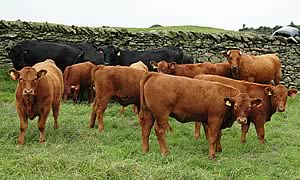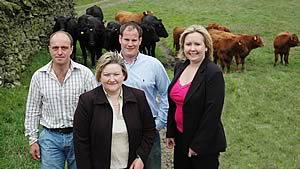 |
|||||||||
|
|||||||||||||||||||
|
|
Great
Support
for the Northwest Stabiliser Project Beef producers throughout the North West are pledging unprecedented support for the Northwest Stabiliser Project.
Within two years of its launch, 12 new multiplier Stabiliser herds have been establised in Cumbria, Lancashire and Cheshire which will subsequently contribute to increasing the pool of breeding stock. More than 200 farmers have registered an interest in the project of which around 35 have ordered either Stabiliser semen or bulls to use over their existing suckler cows and breed grading up replacement heifers. “The Northwest Stabiliser Project which has a projected return of £10.8m to the industry over 10 years, is proving to be a dynamic new venture offering opportunities for all farmers located in Cheshire, Cumbria, Greater Manchester, Lancashire and Merseyside,” said project officer, Lowri Williams. “Interest and take up has been beyond expectations. The farmers who have expressed interest so far have one thing in common, they are all seeking the opportunity to reduce production costs and improve the output value of their suckler enterprises. “The Stabiliser is providing them with a solution at a time when their suckler enterprises are faced with two new sources of pressure out side their control – higher modulation rates and a more competitive global beef market.” She added: “The Stabliser is a composite damline imported nine years ago by the Beef Improvement Group from the USA where it was developed to deliver consistent high quality beef produced for least cost per kilo in subsidy free systems.” More than 9,300 suckler cows throughout the UK were mated to Stabiliser bulls in 2006, decisions which will deliver forecast cost savings of £67 per cow per year in physical performance compared with the EBLEX top third recorded performance suckler herds for 2005/06.
Food Northwest’s Fiona England commented: “We are delighted by the level of progress made by the Northwest Stabiliser Project. All the farmers involved should be congratulated for their progressive view of innovative techniques. This venture will go some way towards making the region’s beef producers more competitive and to improving the quality of its beef.” James Dixon, who farms with his brothers, Andrew and Richard at Kitcrag, Selside, near Kendal is among the Northwest Stabiliser Project’s members and is hosting an open day for the region’s beef producers on Saturday 22 September 2007. Visitors will have the opportunity to discuss with the Dixon brothers, James, Andrew and Richard how the Stabiliser is playing a key role within their suckler herd to improve overall performance and reduce production costs.. “We were convinced right from the start that the Stabiliser concept would not only help us, but all beef producers in the region to work towards a sustainable future,” he explained. “Since we introduced the Stabiliser to our suckler herd, we’re finding that it is ticking all the right boxes. “For example, last season we put a 14 month old Stabiliser bull to a group of 40 Continental cross heifers and 100 pc calved within a period of two cycles, performance which demonstrates the Stabiliser’s early maturity,” he said. “Furthermore, there were no problems when it came to calving - they were an absolute dream. These Stabiliser cross calves seem to have a will to live, they are alert and inquisitive, equally, they have a quiet temperament. They also have the added benefit of being polled. “In addition, the Stabliser is providing us with a welcome opportunity to reduce production costs. This coming winter we plan to feed pure forage diets to the calves and make considerable savings on creep of approximately 70p per head per day.” Eventually the Stabiliser is destined to generate added value at Kitcrag. “We’re confident that the Stabiliser has a real future as a damline and we’ve decided to retain all the F1 heifers for grading up to purebred status and to establish a multiplier herd.” Lowri added: “Stabilisers are not only contributing towards improved output in UK herds, but they are also making savings of up to 20 pc on labour and building depreciation, and a similar level on wear and tear of machinery and power requirements simply because of improvement in feed efficiency from grass thereby reducing winter silage requirements. “Their hardiness is also lending them to being housed later. We are confident that the cattle at Kitcrag will go on and make a similar reduction in production costs and increase the output value of the unit’s beef enterprise.”
Kitcrag Farm, an 180 hectare unit, lies at 600 feet above sea level in the hamlet of Selside, near Kendal. Land is all in the less favoured area with 80 pc of it severely disadvantaged, rising to 1,300 ft above sea level. An adjoining 175 hectare farm, Yoad Pot, is also part of the family business run by brothers James, Andrew and Richard Dixon. James’ son Stephen also works on the farm. The farm carries 300 Swale dale and 250 Mule ewes, with a small flock of Leicester sheep. A new 12,000 bird free range poultry unit has been established at the farm after ceasing milk production in 2003. Following visits to Givendale, Yorkshire, and the Lilburn Estate near Wooler by Dixon family members, it was felt that the Stabiliser breed offered them the way ahead by enabling them to run a low cost, easy care suckler enterprise, breeding their own replacements into a closed herd. The aim is to build up cow numbers to 120-plus Stabilisers, which the family is well on its way to doing. Grading up process 2004 2005 2006 2007
|
||||||||||||||||||

|
|
||||||||||||||||||
| home | agri-services | pedigree
pen | news | dairy | beef | machinery property | organisations | site map |
|||||||||||||||||||

Article by
Jennifer MacKenzie

